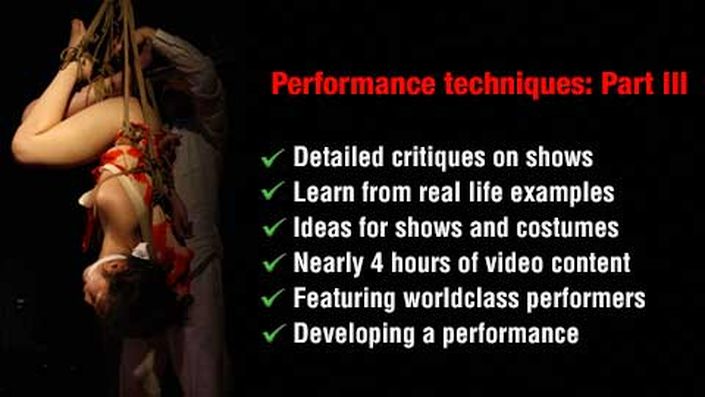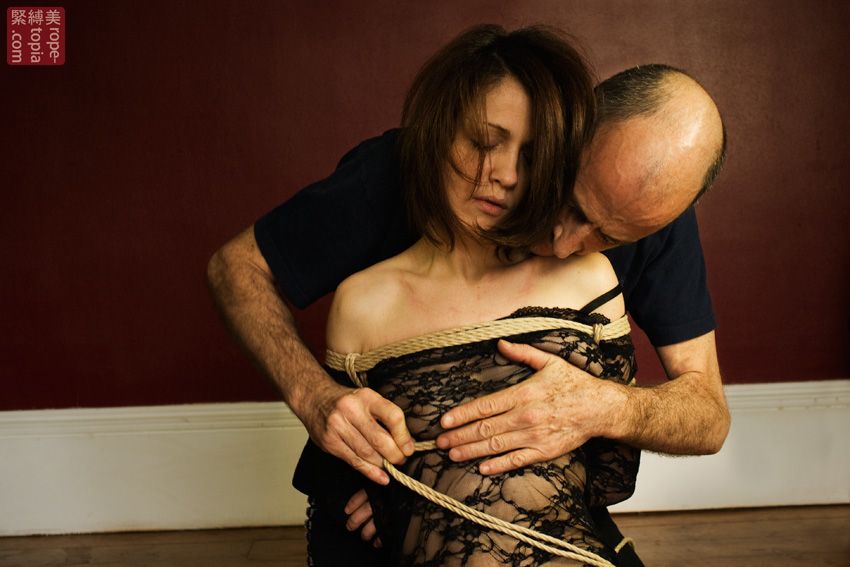
Performance techniques: Part III
Learn how to create a shibari show with numerous examples with analysis and in-depth critiques
Performance techniques: Part III
In this third part of the series, we will look at what makes a shibari performance and explore the various types of kinbaku shows. Having been on the western shibari scene since its earliest days, I have not only seen many hundreds of shows of every conceivable type but also witnessed the development of shibari as a performance art. Thus, Nina and I have a wealth of experience to pass on to you both as observers and as performers.
The London Festival of the Art of Japanese Rope Bondage, which I ran for 5 years with Garry Vanderhorne (now organiser of Lucha Britannia) and Nawashi Murakawa, was pivotal in developing both the art of shibari and as a catalyst for high level shows in Europe and beyond. In addition, visiting festivals around the world, trips to Japan and our regular BOUND event exposed us to countless performances by riggers of all levels, including many of Japan's most revered bakushi, and provided numerous opportunities to perform. As a result, we can draw from an almost unparalleled experience to help you perform to the best of your ability.
In this course, we will look beyond the obvious to help you think outside the box when deciding upon what sort of show to do to capture your audience. The secret is the right show for the right audience. More often than not, it is this and what you add beyond your rope skills that is important. A creative novice who hits the spot can get a better reaction than a far more skilled rigger who misses it. Likewise, I have seen some of the best being almost ignored because they didn't grab the public's attention.
We have included everything from the very traditional old-school style formats that create a series of tableaux to dynamic 'circus bondage', humour, examples of drawing from one's own culture, audience participation and some of the more adventurous modern takes. As learning by example is one of the best methods, we have analysed and critiqued the good, the bad and the ugly so you can see what was done well and what could have been better.
The tutorial contains nearly four hours of video tutorials, critiques and performances from which you will gain invaluable insights into how to develop yourself as the best performer you can be.
Your Instructor

Esinem is a shibari artist who has regularly appeared at UK and international events such as Pride, Torture Garden, Erotica, Rubber Ball, Wasteland, Boundcon, Nuit Demonia and recently represented the UK at Japan's first international kinbaku event, Toubaku. He is also known for his teaching both in the UK and internationally and was co-organiser of the London Festival of the Art of Japanese Bondage and BOUND, Europe's premier monthly shibari event.
Over the last few years, he has been improving his skills in Japan with the help some of their best known and respected kinbakushi, Arisue Go, Osada Steve, Kinoko Hajime, Kazami Ranki and, grand master of newaza, Yukimura Haruki. Whilst drawing from classical methods, his style is distinctive and epitomizes the art of communicating with rope, often departing from the typical serenity of shibari shows and flying in the face of tradition to produce some striking and unusual performances.
In addition, he has worked on various videos, e.g. Primal Scream's 2013, artistic collaborations and photo shoots both on and off camera. He has been involved in projects providing inspiration for Tom Ford's 2013 collection and, Raqib Shaw, an acclaimed artist who has exhibited at the Tate, Metropolitan and White Cube galleries.
He contributed to Rope, Bondage & Power, edited by Lee Harrington and is currently involved with a number of documentaries on kinbaku. He is also author of the first English language tutorial DVDs: 'Japanese Rope Bondage: Tying people, not parcels'.
Nina Russ is a London based, shibari performer, rope artist and educator. She became student of Esinem in 2011 and their collaboration gave birth to BOUND shibari night (2012) and ShibariClasses (2015). She had also the fortune to participate at workshops with different Japanese shibari masters, like: Kazami Ranki, Yukimura Haruki, Kinoko Hajime.
She has performed internationally, most notably at the London Festival of the Art of Japanese Rope Bondage and RopeFest in St.Petersburg. In addition, she participates in numerous artistic, fashion collaborations and local performances. Her passion for rope has lead her on a route of discovery of concepts, philosophy, aesthetics and benefits behind this Japanese discipline.
She sees shibari as an art form which creates deep connection between the participants and also aids personal development. Due to its martial arts roots, it brings self-discipline, efficiency, effectiveness and, thus, growth in confidence and awareness. She believes these skills allow a greater focus on the most important aspects: you, your partner and your shared experience.
Course Curriculum
-
StartIntroduction (5:54)
-
StartExample 1: Bob the Builder show (13:20)
-
StartExample 2: Coven show (35:06)
-
StartExample 3: Kinbaku Magic show (15:38)
-
StartExample 4: Nina Russ show in Rome (50:38)
-
StartSome additional examples (97:16)
-
StartBeing over-ambitious (13:37)
-
StartQ&A forum 'Ask Bruce and Nina'
-
StartRefer a friend and you both get a 20% discount
